
Veterans of two wars: The Renown class battlecruisers were initially planned as two extra battleships of the Revenge class, or which five were already in construction. Admiral Sir Jackie Fisher was rebuffed by the admiralty for more battlecruisers, but after the first battles of 1914, opinion changed, and Fisher convinced Churchill to grant permission to convert the suspended battleships into battlecruisers, despite the fear they might never be achieved during the war.
Eventually, both the Renown and Repulse were completed in record time, pressed into service in August and September 1916, a few months after the battle of Jutland, urging some add-on armor. By that time, the admiralty was once again hostile to the battlecruiser idea, albeit much beefed-up with armour. Both battlecruisers soldiered on until the end of the war and the whole interwar, receving minor upgrades along the way. Only Renown was taken in hands for a full reconstruction which was a sort of peacetime prototype for her sister ship and Hood, the last Battlecruiser in service. She was entirely rebuilt along the lines of the Warspite and emerged after rushing preparations on 28 August 1939, ready for the war with 48 hours to spare…
Their fate in WW2 is well known: HMS Repulse was sent by Churchill in reinforcement to the far east in the fall of 1941 (Force Z), with HMS Prince of Wales: Both were attacked by IJN bombers and sunk. Renown stayed in Europe with the Home Fleet, alternating between the north sea, the north and south atlantic, the Mediterranean and the Far east at the end of the war. From 1942 onwards, she was the last battlecruiser in existence on the planet (except arguably the Turkish Yavuz), last remnant of a short-lived concept.
Foreworld: Jackie Fisher’s first follies
This was not the last class of English battlecruisers, but they marked a new milestone in the evolution of the type, as in terms of tonnage, they were almost superior to the recent dreadnoughts, while being far larger. In fact, in 1917 they became the largest warships afloat worldwide. They held this status until 1920 and HMS Hood. They marked a logical evolution to the 15-inch (381 mm) caliber shadowing the Revenge and Queen Elisabeth classes, ensuring Royal Navy’s superiority over the latest German Battlecruisers then in construction or just planned. Indeed, the contemporary SMS Hindenburg (also completed in 1917) was still limited to the decade old 12-in caliber.

HMS Repulse in 1917
Initial Design (1914)
Battecruiser versions of the Revenge?
Strangely, these giant ships were first started as improved versions of the Revenge, there were three units planned, HMS Repulse, HMS Renown and HMS Resistance, laid down at Royal Dockyards and Palmers. With the early successes of battlecruisers (at Heligoland Bay and Falklands), and the combined pressure of Fisher, Jellicoe, and Beatty on Churchill, the first Lord of the Admiralty, conversion of these ships into battlecruisers was approved at the end of 1914.
The condition was they used the turrets of the Revenge class battleships and Queen Elisabeth, but reduced to 6 guns, to make it practical with the loss or hull strength due to a lighter armour. Very long, these ships shown some structural problems, which were quickly settled. The construction process of their original yards included light alloy manufacturing, but for fear of delaying completion, more classic solutions were eventually chosen.
The battleships of the 1914 Naval Programme had indeed no less than three improved Revenge-class designs, “Renown”, “Repulse” and “Resistance”, and a further member of the Queen Elizabeth class, “Agincourt”. Resistance and Agincourt were allocated to Royal dockyards and Renown to Fairfield, Repulse to Palmers. Aapproved on 13 May 1914 the design was basically a great improvement over the Revenge class, notably because of the following:
– 1.5 inches (38 mm) everywhere for the protective wing bulkheads.
– Enlarged torpedo control tower.
– Enlarged conning tower a rearranged layout for access.
– Protected spotting position in the bow.
– Longer Keel for a more rigid structure amidships and less docking stress.
– Increased Shell stowage to 100.
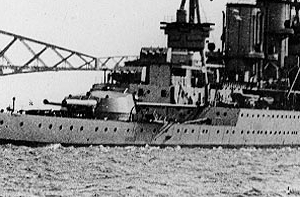
These changes would have done little for chagung their size but perhaps lowering the draught down to 28 feet, 6 inches (8.7 m) and 1 foot 6 inches (45.7 cm) fore and aft. They would have been 2 knots (3.7 km/h; 2.3 mph) slower than a Revenge-class for the same 23,000 kW, since the Revenge produced 30,000 kW.
Complete design revision
However, eventually, work on all four was suspended when the war broke out. Those from Royal dockyards were cancelled on 26 August 1914, since completion before the end of the war was unlikely. Lord Fisher was back as First Sea Lord in October and started pressuring Winston Churchill allow him to convert theses suspended contracts inti new battlecruisers reaching 32 knots (59 km/h; 37 mph).
Churchill opposed Fisher, arguing that their construction would interfere with other programmes and absorb too much resources while still risking not to be completed before the end of the war. Fisher in return argued that construction could be done withing a reduced delay, as done with HMS Dreadnought already, by using as much exusting parts ortdered for existing battleships, notably their 15-inch (381 mm) gun turrets. Churchill at first did’nt bulge, until the Battle of Heligoland Bight in August, and after the Battle of the Falkland Islands in December 1914. Both seemed to demonstrate that battlecruisers were the way forward, by combining speed and heavy artillery. Between an unflinching Fisher, pushing for the viability of the battlecruiser, pressure from Admiral Jellicoe (commander of the Grand Fleet) and Vice Admiral Beatty (commander of the Battlecruiser Force) had Churchill eventually sign the approval, and the Cabinet authorized the two ships on 28 December 1914 and Fisher still hoped for a commission as soon as early 1916.
Fisher’s solutions to urge design
To save time, Fisher proposed to use the armour and equipments already provisioned for the two Revenge class dreadnoughts of the same name. What he proposed was literally to cannibalize them, including their main guns. Speed being the determining factor, Fisher wanted 32 knots. To reach this, he proposed new and lighter machinery using thin-tube boilers, combined with lighter turbines, the type of which were tested on light cruisers. But their development meant no schedule was realistic. A cutback meant the HMS Tiger powerplant was to be used, but with four additional boilers. Protection was inspired, also to save time, from the Invincible class, and fairly light.
Since Jutland’s lessons were still 2.5 years away, Fisher’s illusions about speed bisng used as an active protection remained valid. Even with that protection sacrifice, the ships exited the yards with a greater displacement as initially planned, and could not reach their top speed of 32 knots. It could be obtained by overheating their boilers to the extreme, producing a total of 120,000 hp, and to the cost of a monster consumption of fuel oil. Even in that case, “whipped to blood”, both had a hard time reaching 31 knots. Their new designed speed was lowered below 30 knots, based on 112,000 hp. This figure was nothing short of exceptional nevertheless for a ship that size. This was way above the SMS Hindenburg notably, and remained so until the arrival of the paper-thin Furious and Courageous class, or even the Hood which reclaimed nevertheless most of the lost protection.
Design features of the Renown class

From the start, the hull was designed with light protective bulges as long as the belt. For the adopted secondary guns of a light caliber, the same caliber as n previous vessels was chosen, but instead of barbettes, the more complicated solution of triple mounts was chosen; This triple configuration was a risky but very innovative solution (see later). They were large ships, in order to accomodate all their boilers, with overall length of 794 feet 1.5 inches (242.0 m), and a beam of 90 feet 1.75 inches (27.5 m), a draught of 30 feet 2 inches (9.2 m) deeply loaded. Displacing 27,320 long tons (27,760 t) standard, 32,220 long tons (32,740 t) deeply load they were the longest, but not the heaviest British capital ships of the time. They were indeed 90 feet (27.4 m) longer than HMS Tiger, displacing 2,780 long tons more. Both battlecruisers had fine lines and proved to be good sea boats, but like other earlier battlecruisers, needed to be buffed up, reinforced while under construction with additional stiffening and pillars, right under the forecastle deck. Some structural problems forward were detected linked notaby to the two large turret rings. They had a metacentric height of 6.2 feet (1.9 m) at deep load as built as well as a complete double bottom.
Protection
The light bulges added from the beginning offered a good protection all over the belt. They carried for their hungry turbines some 4,300 tons of fuel and more in wartime. Their armor was directly inspired by the previous Indefatigable class. The armour protection was still classic:
Waterline belt made of Krupp cemented armour (the bes weight-protection ration of that time) and measured 6 inches (152 mm) thick, amidships from “A” barbette to “Y” barbetten, stopping at mid-point. It had a total lenght of 462 feet (140.8 m), 9 feet (2.7 m) high. 3-in armour strake were placed aft, plus 4-in forward to end the ship’s hull on either side of the barbette, down to the bow and stern. These strakes were enclosed by equal transverse bulkheads. Above the waterline belt was place an upper belt made of high-tensile steel just 1.5 inches (38 mm) in thickness for splinter protection.
Gun turrets were 9 inches (229 mm) thick (face) and sides, down to 7 inches (178 mm) for their rear plate. The roof was protected by 4.25 inches (108 mm) thick.
Main barbettes had 7 inches (178 mm) walls above the upper deck, down to 4–5 inches (102–127 mm) below.
Conning tower: 10 inches (254 mm) thick walls with 3-in (76 mm) roof.
Communication tube: It was 3-in thick between the CT and below the protected deck.
Torpedo control tower: Also 3-inch thick walls wit a 1.5-inch cast steel roof.
Armoured decks: Made of high-tensile-steel: They ranged from 0.75 to 1.5 inches (19 to 38 mm).
Modifications: After the Battle of Jutland in 1916, when still completing it was decided to add an extra 1-in (25.4 mm) of high-tensile steel, both for the main deck and over the magazines.
This was still far below the Hood’s protection, and both battlecruisers were still very vulnerable to plunging fire. At last it was decided to sent them for a refit in Rosyth in 1916–1917, adding extra horizontal armour, about 504 long tons in total to the decks, especially over the magazines aas well as the steering mechanism.
ASW protection: Both ships were fitted with a shallow anti-torpedo bulge, integral to the hull. Like other bulges of that time it acted as sâced armor, detonating the torpedo before reaching the main hull. It was also designed to vent out due to its shape the blast wave to the surface rather than underwater, as vibration with pression were much more severe. Post-war tests showed this bulge was not deep enough and lacked extra layers of empty and full compartments insie the hull in backup to really well absorb the force of the explosion.
Propulsion
A said above the intended lighweight machinery was largely experimental and untested for warhips of that size. The plan was altered and to avoid delaying their completion, plans included dusplication of HMS Tiger’s machinery. Three extra boilers were provided for the extra power required to reach the designed speed. The compartments comprised two sets of Brown-Curtis, direct-drive steam turbines housed in their separate engine-rooms. Each set was composed for high-pressure turbines ahead, plus astern turbines for the outboard shafts. They were housed in the same casing and driving the inner shaft. They were given three-bladed propellers 13 feet 6 inches (4.11 m) in diameter. The turbines were fed by high pressure steam coming from 42 Babcock & Wilcox water-tube boilers. They were located in six boiler rooms, at a working pressure of 235 psi. Total output was 112,000 shaft horsepower (84,000 kW). On trials, Renown achieved 126,000 shp (93,958 kW) and reached 32.58 knots, but at great expense in fuel, which was not sustenable. They were the fastest capital ships in the world until the Hood in 1920.
The Renown class battlecruisers were designed to carry 1,000 long tons (1,016 t) of fuel oil in meacetime conditions. In wartime, all vacant spaces and voids on both sodes of the hull and triple bottom represented a maximum capacity of 4,289 long tons (4,358 t) available. At full capacity their top speed could be as high as 18 knots (33 km/h; 21 mph) maintained over 4,000 nautical miles (7,410 km; 4,600 mi). In addition to theior main turbines, The Renown class battlecruisers had two reciprocating, steam-driven, 200-kilowatt (270 hp) dynamos. One was oil-driven (150-kilowatt, 200 hp) and another turbine-driven but 200-kilowatt, supplying the internal electric network of 220 volts.
Main armament

Overview of the armament in 1918
The Renown class battlecruisers, as wanted by Fisher, were to be given the same main armament as the Revenge class battleships, which were their previous affectation. These meain turrets and barrles were ready and usable, allowing to gain considerable time.
These were three twin turrets carrying BL 15-inch Mk I naval guns. These excellent pieces of ordance, perhaps the best evern designed for the Royal Navy has been seen already in detail in the Queen Elisabeth Battleships post.
Let’s just reminds they fired 1,938 pounds (879 kg) shells at 33,550 yards (30,680 m) for the Mk XVIIB or Mk XXII, streamlined shell at 30° elevation.
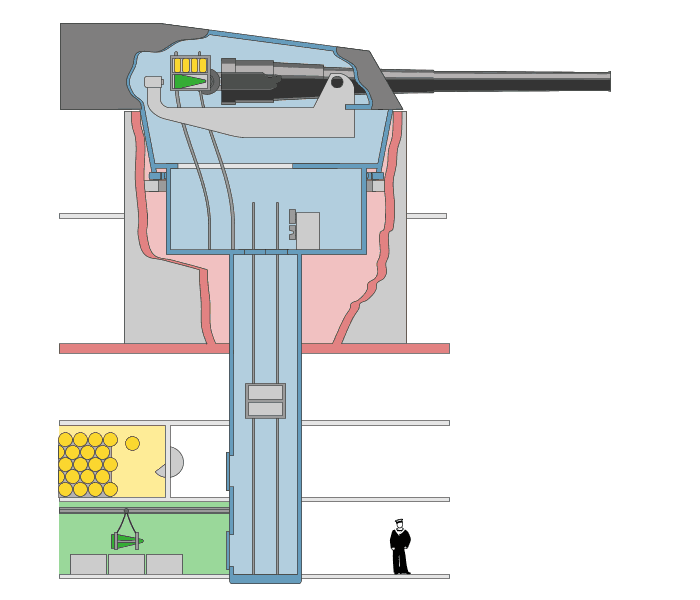
animation showing the 15-in turret reload process
Secondary armament

The Renown class battlecruisers’s secondary artillery used innovative twin and triple mounts, with 4 in (105 mm) Mk.9 guns. These were early semi-automated dual purposed turrets, but they proved too cumbersome and labor-intensive, requiring 32 per turret. All for a relatively low firing rate improper for true dual-purpose guns. The experiment was never renewed and such mounts were eliminated during the 1930s refit. Indeed, the crew’s action in the confined space of the armor mask was made more hazardous by the complexity of the loading system. Both were criticized as being dangerous. The firing arc on paer was excellent as these mounts were placed high on the decks and more serviceable than traditional barbettes often hampered in heavy weather. But in the end, their low caliber made them ineffective agaianst ships, while ther slow rate of fire was useless against aviation. The concept, rushed out without a proper tuning, turned out to be mediocre and was never adopted again.
This main dual armament was seconded by trusted, simpler pieces of ordnance: Two single 3 in (76 mm) AA guns. They could be used to fire flares or blank shots as saluting guns as well. These QF 3 inch 20 cw on single high-angle mountings were placed on the shelter deck abreast, the rear funnel. Max depression was 10°, max elevation 90°. As standard they fired the 12.5-pound (5.7 kg) shell (2,500 ft/s) for about 12–14 rounds per minute up to 23,500 ft (7,200 m) max range.
Torpedo Tubes: As customary at the time, the Renown class battlecruisers had just two submerged tubes abreast, forward of the “A” barbette not to comprimise armour. A total of ten torpedo reloads were carried.
Fire control
The Renown class battlecruisers received nothing really innovative, just the provisioned telemeters and ballistic computers, fire tables of the Revenge class:
The Main guns were directed thanks to a pair of fire-control directors. The primary one was placed above the conning tower, in an armoured hood. The other was much higher, placed atop the foremast. Data was input into a Mk IV* Dreyer Fire Control Table which sat in the Transmitting Station (TS). It was converted into range/deflection data sent to the turrets indicators.Target’s data was graphically recorded on a plotting table, to be followed by the gunnery officer. He could predict targets movements that way.
The secondary armament depended on platform-mount directors, on each mast. Each turret in addition had a 15-foot (4.6 m) rangefinder on the turret roof. They were upgraded during the war to two 30-foot (9.1 m) models, one on “Y” turret and the second above the conning tower in 1918. 15-ft rangefinders landed also on “A” and “B” turrets. One was placed over the torpedo control tower, abaft the mainmast. On the fore-top, a new 12-ft (3.7 m) rangefinder was added. The anti-aircraft guns were controlled by a single 6 ft, 6 in (1.98 m) model placed on the aft superstructure and extra 9-foot models landed on the bridge also during wartime modifications.

Repulse firing in 1929

Author’s illustration of the Repulse in 1918
Renown & Repulse Specifications 1916 |
|
|---|---|
| Dimensions | 242 x 27,4 x 7,8 m (full load) |
| Displacement | 27 600 t, 30 800 T Fully Loaded |
| Propulsion | 4 shafts turbines Brown-Curtis, 32 B&W boilers, 112 000 hp |
| Speed/Range | Top speed 30 knots, RA 5000 nautical at 12 knots |
| Armament | 6 x 381 (3×2), 17 x 102 (5×3, 3×1), 2 x 76 AA, 4 x 47, 2 x 533mm (Sub) TTs. |
| Armor | Belt: 6 in, Decks 2.5 in, Barbettes 7 in, turrets 9 in, CT 10 in, Bulkheads 4 in |
| Crew | 950 |
In service: WW1
HS Repulse was completed on 18 August 1916. Her construction cost has been £2,829,087 (That would be £ 159,700,000 in 2021) and joined the Grand Fleet in the North Sea. She relieved HMS Lion as flagship of the 1st Battlecruiser Squadron (for what remained of it). She was found in action at the Second Battle of Heligoland Bight in 1917:
The Admiralty that year became concerned about German action to clear the British-laid minefields restricting and channeling in known areas, the actions of the High Seas Fleet, but also U-Boats inbound for the Atlantic. German mineswers made a raid in force on 31 October, covered by light forces. The Admiralty decided to destroy this fleet, based on intelligence reports. The date was 17 November 1917: They allocated two light cruiser squadrons, the 1st Cruiser Squadron, covered by the 1st BCS (Renown was not in it still)a and in distant backup, battleships of the 1st Battle Squadron.
The Four light cruisers of 2nd German Scouting Force was reinforced by eight destroyers, and covered three divisions of minesweepers, which used eight Sperrbrechers -cork-filled trawlers to detonate mines- and two trawlers to mark the path. They were the first to be spotted, at 7:30 a.m. on the rising sun. HMS Courageous and Cardiff opened fire first. The Germans layed an effective smoke screen but the pursuit went on, until loossin track of most of the smaller ships. The German light cruisers also counterfired efficiently. At last, HMS Repulse raced forward at full speed to engage the cruisers opening fire at about 9:00 AM, and scoring a hit on the SMS Königsberg, her only significant contribution to the battle. Indeed the battleships SMS Kaiser and SMS Kaiserin, the backup force arrived in between and were spotted about 9:50 and the British force broke off their pursuit. HMS Repulse covered their retreat all along, while a heavy fog came about 10:40. In all, Repulse had fired no less than fifty-four 15-inch shells. Königsberg only temporarily reduced her speed but returned home safely and undergone short repairs.
Nothing much happened for the remaining of the year, at least until 12 December 1917, when Repulse was damaged in a collision with HMAS Australia. She stayed in the firth of forth, still the flagship of the 1st BC force, until V-Day. Renown on her side never fired a shot in anger during the war. On 12 December 1917 she followed the grand fleet in an unsuccessful attempt to intercept the German 3rd Half-Flotilla of destroyers which destroyed a Scandinavian convoy off the coast of Norway. Like her sister ship she patrolled the North Sea uneventfully. Repulse and Renown escorted the Hochseeflotte for their surrender on 21 November 1918 later disarmed as per the armistice conditions. Overall, Their career during the Great War was barely significant, since the Admiralty just was weary about exposing them in battle. In 1918, experts estimated some vital parts could still be penetrated by 6-in shells.
1916-1917 Modifications
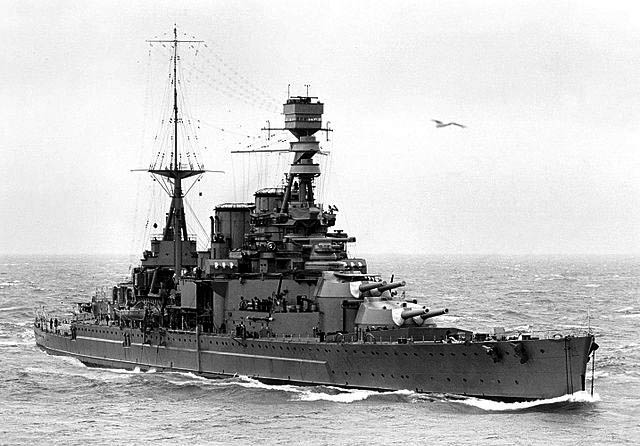
When they entered service with the Grand Fleet, the battle of Jutland had just ended and battlecruisers had lost credibility. The turmoil caused by the loss of Beatty’s “splendid” caused such outrage that some in the government purposely offered to set disarm the ship and reaffect the crews. When the calm return however, the admiralty decided by the voice of John Jellicoe to have the remaining Renown class upgraded wth some 500 tons of extra armor, mainly above the mot sensitive parts, the ammunition bunkers and steering room. Their fore funnel was raised in November 1916, because of the inconvenience caused by smoke interference for fire direction. In the fall of 1917, s small platform was fitted on their ‘B’ turret, the first time it was done for the Royal Navy. The small biplane, a Pup or Camel was used for observation. The 20 meters patform prolongated the main turret roof, being attached to the turret’s guns by the way of struts. This was not without problem in case of firing them. In that case, the need to differenciate the elevation or just firing would have blasted the platform intantly. Nevertheless, this platform was experimented again in the 1920s, and ways to quickly fit or demount it.
1918 Modifications
In 1918, modifications were made on the Reuplse, notably baffles were installed and new projectors placed in armored towers along the aft funnel, while the long hull structure was braced and reinforced while the Fire control room was rearranged, fire direction modernized with upgraded telemeters, and new extra ones installed, notably for the new Duel-Purpose 4-in installed, and Bofors guns. The protection in 1918 was further reinforced on the Repulse, with the armor removed from the former battleship Cochrane, requisitioned in 1914 and now transformed into an aircraft carrier (see Eagle). By the end of the year, Renown had to wait for the availability of a new armor set, received in 1923-26.
Repulse in the Interwar

Both modern battlecruisers were spared by Washington’s tonnage cuts in 1921, but had to be partially redesigned in the 1920s and early 1930s. It was unequal, yet. When WW2 broke out, only Renown had been comprehensively modernized. Repulse suffered the same fate as Hood, which was far better protected, of just cosmetic changes.
HMS Repulse started a major refit at Portsmouth on 17 December 1918. It was intended to improve considerably her protection and her original armour belt was replaced by a new 1/3 thicker (9-inch or 229 mm) armour plate, surplus from the conversion of Almirante Cochrane. The original armour in tun was reinstalled between the main and upper decks, and above the new armour. Additional high-tensile plating also was added the decks, and over the magazines (in additon to what was added already in 1917). Her anti-torpedo bulge were deepened and reworked, following the same design scheme as for the battleship Ramillies. The bulge was longer too, covering from the submerged torpedo room to “Y” barbette magazine. Its inner compartments were filled with crushing tubes. With these new bulges, the beam took 12 feet 8 inches (3.9 m) while the extra weight made the draught deeper from 1 foot 4 inches (0.4 m). In all, 4,500 long tons of stell was added to the displacement. Metacentric height jumped to 6.4 feet (2 m) deeply load. New very large rangefinders were also added and the hull TTs eliminated for four twin torpedo tubes mounted on the upper deck. The flying-off platforms were removed. This refit cost £860,684, to compare to the £2,829,087 of her original construction cost (almost half).
HMS Repulse was recommissioned after this, on 1 January 1921. She joined the Battlecruiser Squadron, Atlantic Fleet, with her suister ship and soon, HMS Hood. In November 1923 the latter, plus Repulse and some D-class cruisers made the 1st Light Cruiser Squadron. Tey set out on a world cruise, west to east via the Panama Canal, returning after ten months at sea, in September 1924. On Repulse, two of the 3-in AA guns and two single 4-in mounts were removed. They were replaced with four new QF 4-inch Mark V AA guns. The Battlecruiser Squadron made another tour, visiting Lisbon in February 1925 for the Vasco da Gama celebrations and in the Mediterranean. A first for Repulse. There, they took part in several exercises. At some point, HMS Repulse hosted the Prince of Wales for his tour of Africa and a squash court was managed on the starboard side, between the funnels. The tour also included South America, until October 1925. She had her second major refit, starting imediately in November 1925 and until July 1926. A new high-angle control position (HACP) was added to her fore-top among others.
1925-26 modernization
Repulse Specifications 1926 |
|
|---|---|
| Dimensions | Beam 89 ft 11.5 in, draft 29 ft 8 in |
| Displacement | 34,600 long tons (35,200 t) |
| Speed/Range | Top speed 30,5 knots, RA 3,650 nautical at 12 knots |
| Armament | Addition 6 single 4-in DP, 2 x 4 40 mm 2-pdr AA |
| Armor | Belt: 9 in, Decks 4 in |
| Crew | 1,181 |
1933 Repulse Reconstruction
After her 1926 refit, Repulse returned for another serie of light moditications in July–September 1927, but served in between with the Battlecruiser Squadron until paid off in June 1932, as for her major reconstruction in April 1933. She entered the drydock to be gutted, basically.
Armour:
Most of the existing high-tensile steel layers for the decks was replaced by non-cemented armour plates, 2.5–3.5 in (64–89 mm) thick. The torpedo control tower was removed entirely.
Aviation:
A fixed catapult was installed in place of the midships 4-in triple turrets, and a hangar built on either of her aft funnel, to house two Fairey III floatplanes. One additional Fairey III could be carried on deck (protected by a tarpaulin) and one more on the catapult if needed, so four in all. Electric cranes were fitted above each hangar for handling them.
Armament:
Her four vintage 4-in AA guns were relocated: A pair abreast the rear funnel at hangar roof level, the other abreast the fore funnel, forecastle deck. Four brand new QF 4-inch Mark XV DP guns were added in twin Mark XVIII mounts, abreast the mainmast. Also two octuple Mark VI, 2-pdr mounts were placed on extensions of the conning-tower platform, abreast the fore funnel. Also a pair of quadruple Mark II* mounts with tandem 0.5-inch Vickers Mark III HMGs were placed above them. These machine guns fired a 37.6 g bullet at 2,520 ft/s to about 5,000 yd (4,600 m), in practice barey 800 yd (730 m). This was considered a close-in defense.
Other modifications:
Two High-Angle Control System (AA directors) were added, one Mark II placed on the fore-top, and one Mark I* on a pedestal, above the aft superstructure. The two submerged torpedo tubes were removed entirely, the former spaces turned into store-rooms.
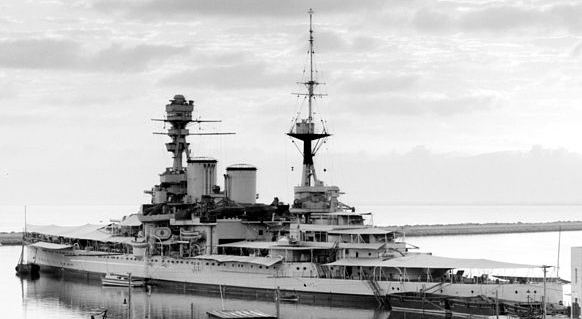
Repulse in Haifa during the Arab revolt in 1938
When she emerged from the yard and was pre-recommissioned, HMS Repulse sailed to join the Mediterranean Fleet. She was recommissioned there officially in April 1936. Her first mission was to cary 500 refugees from Valencia and Palma, Majorca to Marseilles as the Spanish Civil War just started. In 1937, she was back home to participate in the Coronation Fleet Review at Spithead for George VI. Back to the Med, she was in Haifa in July 1938, to maintain order, during the Arab Revolt. The hosted also the Royal coupled during their May 1939 Canadian Tour. From October 1938 to March 1939 she was modified to perform this role but her armament was reinforced also, her twin 4-in AA guns were replaced by two more Mark V and two extra quadruple .50-cal. Vikers HMS mounts. The King and Queen however changed their mind and travelled aboard the RMS Empress of Australia, still escorted by Repulse on the first half of the journey. As wide decision as interbational tensions meant the battlecruiser could be requisitioned at any moment.
HMS Renown interwar service & reconstructions
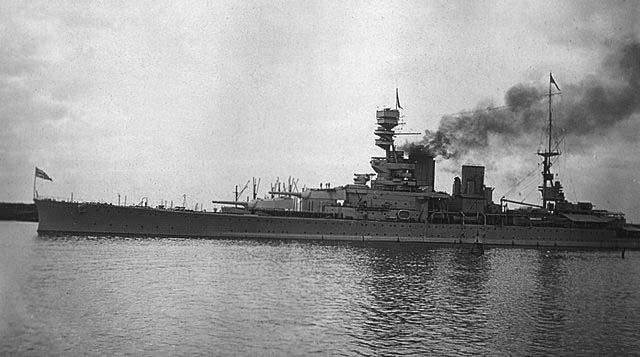
The Grand Fleet was disbanded in April 1919. So Renown was assigned to the Battlecruiser Squadron, Atlantic Fleet but in June she was prepared ti host the Princes of Wales in preparation for a tour of Canada, Newfoundland and the United States. Both flying-off platforms were removed, a 30-foot rangefinder added, a 20-foot one the conning tower. By January-March 1920 she served as a “royal yacht” and her aft 4-in and 3-in AA guns were removed, making room for extra accommodation and promenade deck. A large deck house was built on the shelter deck between the funnels housing a squash court port, and cinema on starboard. She sailed in March for Australia and New Zealand, making many stops en route. She was back to Portsmouth in October 1920 and decomm. for a short overhault and refit.

HMS Renown was recommissioned in September 1921, again hosting Edward PoW for tour of India, the Philippines and Japan, back to Portsmouth in October. In June 1922 she was placed in reserve in July for a reconstruction identicatl to her sister ship, but with fixes based on ealier experience. For example, her new belt was installed about 3 feet (0.9 m) higher to offset draught increase. Aso she received a strake of tapered armour underneath the main belt to deflect incoming shell diving beneath the surface, 9-in thick down to 2 inches. Two longitudinal bulkheads were added between the upper and main decks and ASW bulges reworked, simialr to those of the Queen Elizabeth-class battleships with crushing tubes only abreast the magazines. The B turret flying-off platform returned but a high-angle control position (HACP) was added to the fore-top. Total reconstruction coast was £979,927, more than her sister-ship, but less than 1/3 of her original cost of 1916.
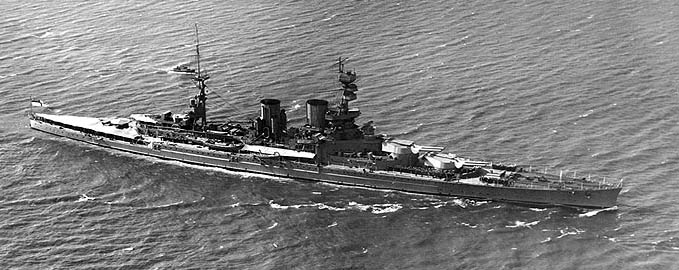

Repulse in Vancouver Canada during its world cruiser 1923-24
After her reconstruction in September 1926, she was assigned to the Battlecruiser Squadron, and detached to escort The Duke and Duchess of York to Australia in January-July 1927. While she was on her way back, there was a fire in her boiler room on 26 May 1926. Four ratings died before it was put out. Back to the Atlantic Fleet she became flagship of the BCS as Hood was absent for refit in 1929-1931. Renown refitted fterwards, reeiving a Mark I HACS and the fore-top received a new high-angle rangefinder, the conning tower platform enlarge for two Mark V octuple QF 2-pdr ‘Pompom’ Mark VIII. The midships triple 4-in mount were removed and an aircraft catapult prepared, eventually fitted in 1933 and a Fairey III floatplane given for reconnaissance and spotting. She collided with Hood on 23 January 1935 during exercises off Spain. Her bow was temporarily repaired at Gibraltar and completely at Portsmouth until May. Her Captain (as Hood’s) were court-martialled as well as Rear Admiral Sidney Bailey, but Renown’s Captain Sawbridge was the only relieved of command, later reinstated by the Admiralty, criticising Bailey for ambiguous signals. She also took part in King George V’s Silver Jubilee. Back to Gibraltar she observed the Second Italo-Abyssinian War from Alexandria in January 1936 (1st Battle Squadron). In May 1936 she rejoined the Home Fleet.
Repulse in WW2
HMS Repulse never received the same attention as her sister-ship, her redesigns were superficial. As the Second World War broke out, HMS Repulse still served in the Home Fleet’s Battlecruiser Squadron, atlantic fleet. She patrolled off the Norwegian coast and North Sea, searching for German ships and enforce the blockade in September-October 1939. When at port, her remaining aft vintage triple 4-in mount was replaced by a 8-barrel 2-pounder AA. By late October, she sailed to Halifax with HMS Furious, protecting a convoy while still looking for German raiders. Early into the war, she chased for the Graf Spee, escorting the Furious and Ark Royal.
Repulse and Furious made another sortie from Halifax on 23 November, this time searching the German battleship Scharnhorst after signalled by the AMC Rawalpindi (sank in action soon after). However Repulse was damaged by heavy seas as a north sea winter storm hit them. She was forced to return to port for some repairs. She was soon back at sea to escort a convoy carrying the 1st Canadian Infantry Division to Britain on 23 December 1939. In February 1940, she escorted the Ark Royal on a fruitless search for six German blockade runners sighted off Vigo (Spain).
Norwegian Campaign
HMS Repulse was assigned in support of Allied operations during the Norwegian Campaign in April–June 1940. On 7 April she was ordered to intercept what was another reported German breakout attempt into the North Atlantic. She was detached to search for an unknown German ship reported by the destroyer Glowworm. It happen to have been the German cruiser KMS Admiral Hipper, which sank the Glowworm before Repulse could arrive. She was recalled to join Renown south of the Lofoten Islands. On 12 April 1940, HMS Repulse was ordered back to Scapa Flow to refuel and escorted a troop convoy to Norway on her way back. In early June she returned in the North Atlantic to search for German raiders. She was absent during the evacuations of Norway.
Accompanied by Renown (1st Cruiser Squadron), Repulse attempted to intercept Gneisenau sailed from Trondheim in July 1941. Until May 1941, Repulse went on her escort duties and on 22 May, she was diverted from Convoy WS8B to search for KMS Bismarck. She broke off however as soon as 25 May, low on fuel. She entered the drydock for a summer refit, from June to August 1941. Eight Oerlikon 20-mm were added during this refit and a new Type 284 surface gunnery radar. She escorted another troop convoy around the Cape of Good Hope in August-October before being recalled to be transferred to the East Indies.
Force Z, the Far East
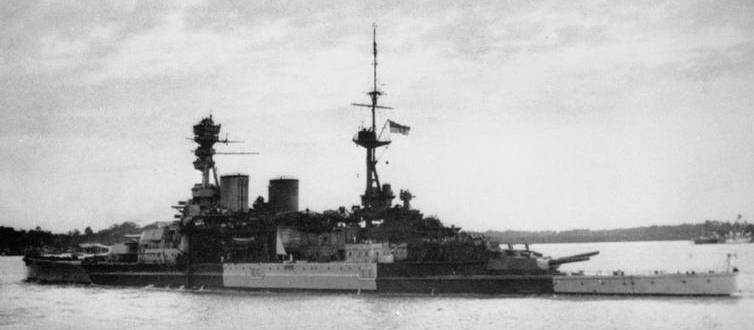

HMS Repulse camouflaged, escorting convoys and departing from Singapore in December 1941
By late 1941, PM Winston Churchill wanted a small task force of fast capital ships to reinforce Singapore, as well as an aircraft carrier, expecting a Japanese move there. In November 1941, Repulse was already in the Indian Ocean and sailed to to Colombo (Ceylon) meeting the Prince of Wales. HMS Indomitable was delayed as she ran aground in the Caribbean. Prince of Wales and Repulse plus their escrt of destroyers maed Force Z, arrived on 2 December 1941. On 8 December, admiral Tom “Thumb” Philips order Force Z to depart in an attempt to destroy a Japanese troop convoys and intercept Japanese landings to their rear.
Force Z was underway when the submarine I-35 spotted it in the afternoon, 9 December. IJN Cruiser’s floatplanes latter spotted Force Z, confirming its compoisitin and heading. They were repetedly spoytted and reported until dark. Admiral Sir Tom Phillips knew at that time his “suprprise” wa no longer on his side, and cancelmled the whole operation. Force Z headed back for Singapore that evening, after a deceiptve manoeuver, making them believed they were heading to Singora instead. At 00:50, 10 December, Admiral Philips was informed of a landing at Kuantan and altered course; Philips expected to fell upon the landing force.
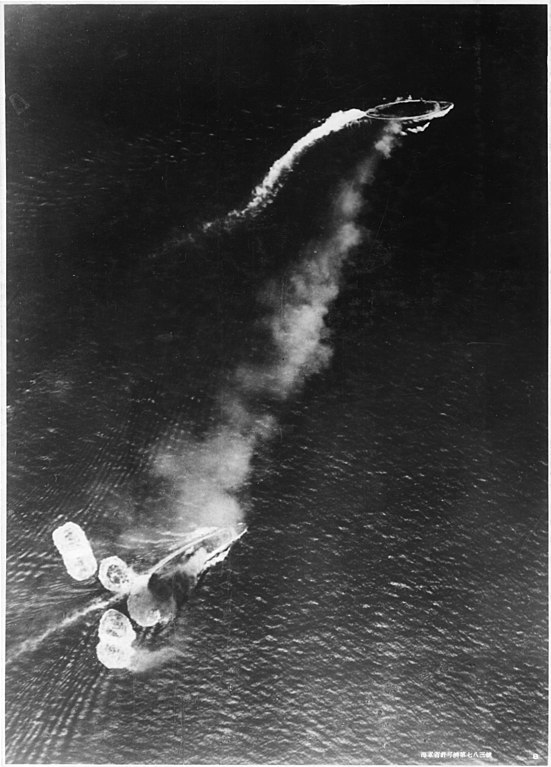
I-58 spotted Force Z again at 02:20, firing five torpedoes but missing. The Japanese the scrambled 11 reconnaissance aircraft, takng off just before dawn, to try to locate Force Z again. Before even they were spotted, some 86 bombers (22nd Air Flotilla) took off from Saigon, carrying bombs or torpedoes. A single isolated Mitsubishi G3M, used as reconnaissance bomber, spotted Force Z agan at 10:15. Position was radioed to the HQ and signalled to the 22nd flotilla. The pilot went on shadowing Repulse and PoW all along, broadcasting to the Japanese bombers while underway.
The first wave of eight G3M bombers arrived on 11:13 and started dropping their 250 kilograms (551 lb) bombs from 11,500 feet (3,505 m). Renown was straddled by two near misses, while a third hit. It penetrated through the hangar and explode just over the armoured deck, which played ot role. Apart casualties and the loss of the Supermarine Walrus (later pushed over, not to risk a fire hazard), there was no serious damage. AA fire from Repulse damaged five of these. Two turned back to Saigon but the others remained on site. Let’s cite here the captan of HMS Renown, Bill Tennant, which skillfully managed to steer his shiped literraly between droppings, avoiding 19 torpedoes when the second phase of the operation started, and all remaining bombs.
But in the end, the Japanese were skilled in the art of coordinate attacks: They made a synchronised pincer attack, led by 17 G4M torpedo bombers, that Repulse coud not avoid. She took five torpedoes hits in rapid succession. Her AA gunners managed to shoot down two planes, damaging eight, but ths was too late. At 12:23, crippled by multiple under waterline breaches, took thousands of seawater liters and listed severely to port. This became so severe that she quickly capsized, with the loss of 508 officers and men. HMS Electra and Vampire stayed to rescue survivors, Captain Tennant srviving as well.
The wreck site became a ‘Protected Place’ in 2002 (Military Remains Act 1986) to avoid pirate actions. It seems the ships took five torpedo hits, four port, one starboard. They hit amidship, abreast of the rear turret and close to propellers. This was precised during a 2007 diving expedition confirming only two hits, portside near the propellers, starboard amidship. Otherse were buried in the ocean floor. Nevertheless, in 2014, the Daily Telegraph reported both ships had been “extensively damaged” by explosives from illegal scrap metal dealers.

Author’s illustration of the Repulse in Dec. 1941
HMS Renown in ww2
Renown’s major reconstruction 1936-39
Renown by that time was considered by the admiralty to be used as a prototype for reconstruction, in September 1936. Design proposals were considered, the first accepted was based on battleship HMS Warspite’s own reconstruction plans, the latest on offer. The ship was drydock, armament was partly removed, as well as the superstructure and funnels. All were razed down to the upper deck to have a clean state. The masts were also removed as well as the TTs and the while secondary armament. Only the clean deck and three main turrets remained.

Profile drawing in 1939 (CC)
-A large section of the middle deck was removed to access the powerplant several decks below.
-A large splinter-proof tower superstructure was constructed forward.
-A new director-control was built on top to direct the main armament.
-Alongside it on a platform, were installed two model HACS Mark IV directors for the secondary armament.
-The conning tower armoured hood was reinstalled on the aft superstructure.
-The ship’s engines and boilers were replaced by Parsons geared turbines and eight Admiralty three-drum boilers
-New output figures were 400 psi (2,758 kPa; 28 kgf/cm2)
-Overall reduction of 2,800 long tons (2,800 t) of machinery weight
-Two freed forward boiler rooms converted to 4.5-inch (110 mm) magazines.
-Deck protection upgraded with extra non-cemented armour
-New 4.5-inch magazines armour stray.
-Hangars built abreast the rear funnel, catapult fitted in between the aft superstructure.
-15-inch gun turrets upgraded to Mark I (N) standard, 30° elevation.
-20x dual-purpose QF 4.5-inch Mark III guns (5×2) BD Mark II mounts* installed abreast the fwd funnel and main mast.
-4 DP Mark IV directors installed, rear of the bridge and aft superstructure.
-HACS Mark IV analog computer for AA fire installed
-Admiralty Fire Control Clock Mark VII for low-angle targets
-3×8 Mark VI 2-pdr ‘Pompom’ installed, platform between funnels and aft superstructure.
-3 Mark III* director provided for them
-4×4 Vickers .50-cal. Mark III added, forward and rear superstructures.
-Sub. TTs removed, 4×2 deck TTs installed.
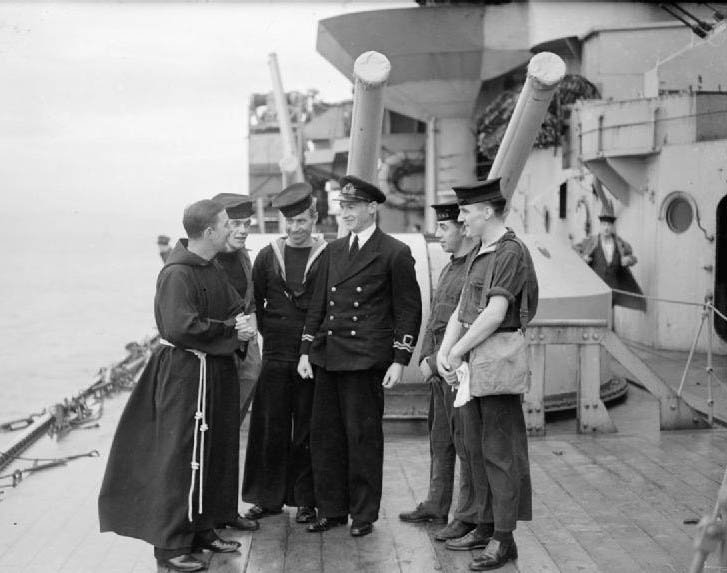
*These BD Mark II mounts had a −5° to +80° elevation and the Mark III gun fired a 55-pd (25 kg) HE shell at 2,457 ft/s (749 m/s), 12 rpm, max ceiling 41,000 ft (12,000 m), 400 rds in store each.
In the end, the reconstruction cost £3,088,008, more than the ship’s cost in 1916 (inflation included) three time that of earlier reconstructions. No doubt that was a concern for the budget-restraint Royal Navy in 1936-37.
Renown in the Second World War
Renown was recommissioned on 28 August 1939, a few days before WW2 broke out. She required some training with a rookie crew before joining the Home Fleet. At that point, her career mirrored her sister ship: She patrolled the North Sea, was transferred to Force K (South Atlantic) in October in search of Admiral Graf Spee. She joined Force H at the Cape of Good Hope in November 1939 in an attempt to prevent Admiral Graf Spee to reach the South Atlantic. Underway, her spotter plane located the blockade runner SS Watussi, which she sank on 2 December. Admiral Graf Spee was scuttled on 17 December but Renown was still patrolling the area, returning to the Home Fleet in March 1940. She was by then flagship of the Battlecruiser Squadron. Hood indeed, was just decomm. for a refit.
Norwegian campaign
HMS Renown took part in the Norwegian Campaign: She engaged Scharnhorst and Gneisenau on 9 April 1940, but the latter quickly folded and departed in the heavy fog, leaving behind Renown and Repulse. The British battlecruiser spotted the Germans and fired first, however the Germans hit her first, two 11 in (280 mm) shells which did slight damage. In return, she hit Gneisenau with a single 15-inch and two 4.5-inch shells (The weather was mediocre, vibility poor and ships were closer, so the secondaries were at the party). She knocked out Gnesenau’s main fire-control director, damaged the rangefinder over ‘A’ turret.
Nevertheless, the “terrible sisters” were still faster than Renown and thanks to the heavy weather they disengaged after and exchange of 90 minutes. Renown lost their sight and it was time for a report. The captain received new that Renown had fire no less than 230 main rounds and 1065 recondary rounds, all for tow hits. This speaks volumes about accuracy at that time, still. Renown came back for repair from 20 April to 18 May 1940. Afterwards, she provided cover during the evacuation fro Norway in early June 1940. After this episode she was transferred to Force H (Gibraltar) in August 1940, relieving Hood as flagship, which returned to the Home Fleet (and met her fate in May).
Mediterranean campaign
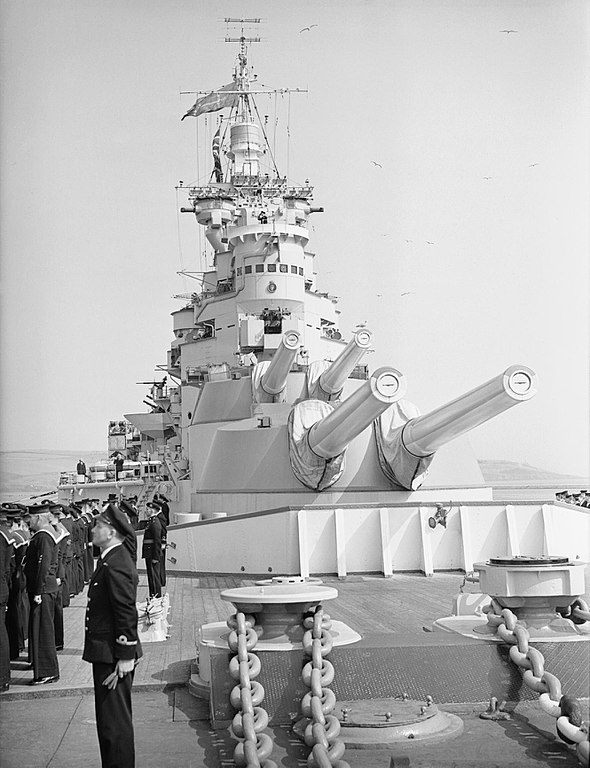
In November 1940, Force H covered HMS Argus, carrying Hurricane to Malta from Sardinia. Force H also participated in the inconclusive Battle of Cape Spartivento. Renown later shelled Genoa on 9 February 1941. She then followed Force H, escorting convoys inside and outside the Mediterranean until May 1941. As Bismarck was spotted and Churchill ordered she was sunk, Force H was scrambled in the Atlantic in turn. Back to base underway, Renown intercepted the German supply ship Gonzenheim en route to resupply Bismarck on 4 June 1941.
Force H escorted another convoy to Malta in July 1941. She returned home for repairs (starboard bulge) in Augist. Her radar was upgraded at that time, notably the Type 284 radar (surface gunnery control radar) and the Type 285 AA gunnery radar and the Type 281 air warning radar, plus the Type 271 surface search radar. She also received two more quadruple “pom-pom”, one on ‘B’ turret. After this refit she was transferred to the Home Fleet in November 1941, as deputy fleet flagship (Duke of York was indeed sent to carry Winston Churchill to the Arcadia Conference, Washington, D.C. on 9 December 1941). Renown escorted several convoys to the Soviet Union (Mursmansk), by early March 1942. Duke of York came back on 3 April and retook the role of flagship.
Renown became however the flagship of Force W to escort carriers taxiing fighters t Malta in April–May 1942. HMS Renown then returned to the Home Fleet, and shortly after a quick overhaul and supplies, was ordrered back to Force H in October 1942. She participated in Operation Torch. She covered the invasion and reinforcements convoys, guarding them to any Vichy French attack or frm the Regia Marina.
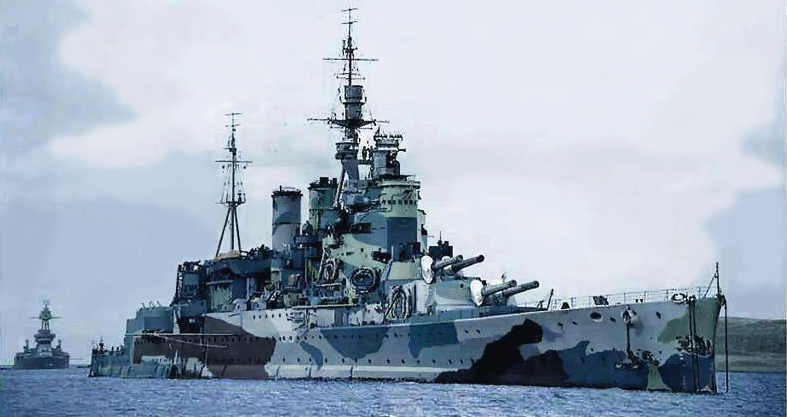
Last refit
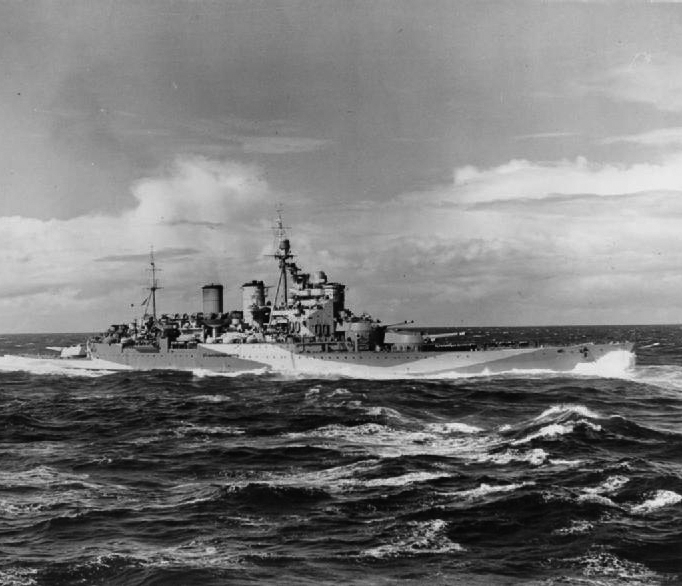
Renown was back home for a refit, starting in February 1943. It lasted until June 1943. Her catapult and associated aircraft were removed. The hangar was converted into a laundry/cinema. No less than seventy-two Oerlikon 20 mm AA guns, in 23 twin mounts, 26 single. Between July 1942 and August 1943. In January 1944 a quadruple “pom-pom” mounting was placed on the roof of ‘B’ turret and the 20mm guns there were re-sited elsewhere.[36] Additional light AA directors with Type 282 radars were also fitted during this time.[37] The ship brought Winston Churchill and his staff back from the Quebec Conference in September and conveyed them to the Cairo Conference in November. She rejoined the Home Fleet in December, just in time to be transferred to the Eastern Fleet a few weeks later.
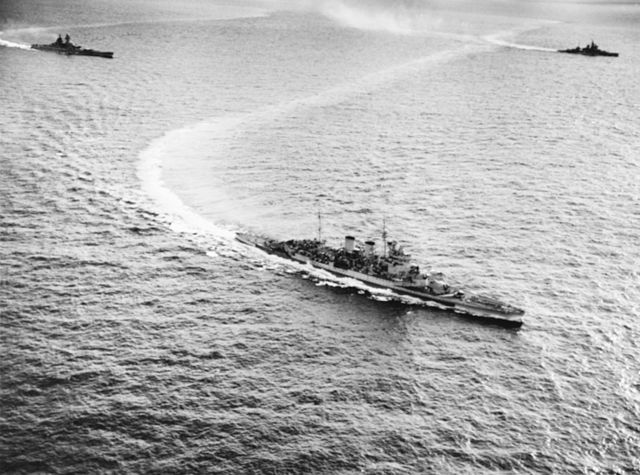
Renown close to the battleship Valiant and Richelieu in the Indian Ocean, 12 May 1944
Renown arrived in Colombo in the fall of January 1944 and became flagship of the 1st Battle Squadron. In April 1944, she participated in Operation Cockpit, an air strike against Sabang’s port and oil facilities. She sailed to take postition off the island of Sumatra and shelled the facilities on Car Nicobar (Nicobar Islands) as well as Port Blair (Andaman Islands), on 30 April and unti the 1st of May. HMS Renown also covered the carriers launching an air strike against Surabaya, Java (Operation Transom), on 17 May. Sje was alo covering the follow-on attack against Port Blair, on 21 June. She made another air strike on 25 July, on Sabang, and shelled the Japanese-occupied city as well. She shelled installation in the Nicobar Islands on 17–19 October. On 22 November 1944, HMS Renown conceded her place as flagship to HMS Queen Elizabeth. She sailed for a refit at Durban, starting in December 1944 to February 1945. In March she was back n home waters and prepared in case of a sortie of remaining German Kriegsmarine ships, reaching Rosyth on 15 April 1941.
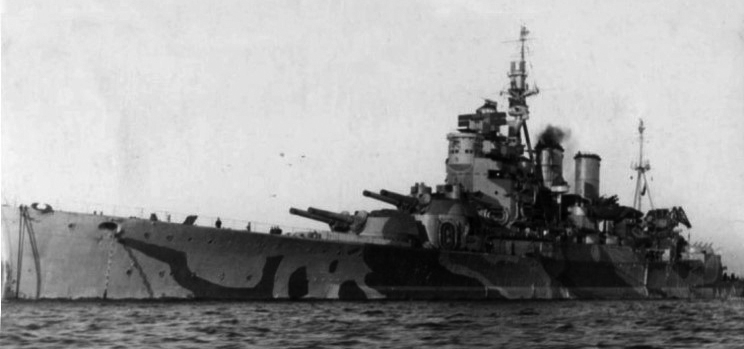
Her very last planned refit was to be brief, but even that was considered not very useful due to her old age and was placed in reserve, in May 1945. HMS Renown was partially disarmed in July 1945. wAt first, six of her 4.5-inch turrets were removed (they were to be fitted elsewhere, using remote power control). The refit was cancelled eventually and Renown last public appearance was then she hosted a meeting between King George VI and President Truman, on 3 August. The latter came previously aboard the heavy cruiser USS Augusta. Decision to dispose of Renown was announced on 21 January 1948 after Four years of mothball reserve. She was eventually towed to Faslane to be scrapped on 3 August 1948, the very last of Admiral Jackie Fisher’s battlecruisers, as Yavuz herself (The former Goeben) was retired in 1947.


Specifications |
|
| Dimensions | 242 x 27.4 x 9.7m (794 x 90 x 32 ft). |
| Displacement | 36,080 t. standard, 36,660 t. Fully Loaded |
| Crew | 1,200 |
| Propulsion | 4 shafts Parsons turbines, 8 Yarrow boilers, 120,000 hp. |
| Speed | Top speed 31 knots, RA 6,580 nautical at 18 knots. |
| Armament | Same but 5×2 4-in (113 mm) DP, 3×8 40 mm AA, 3 Walrus seaplanes. |
| Armor | 355 mm turrets, 160 mm decks, 152 mm rangefinders, 406 mm turrets, 38 mm barbettes, 343 mm CT. |
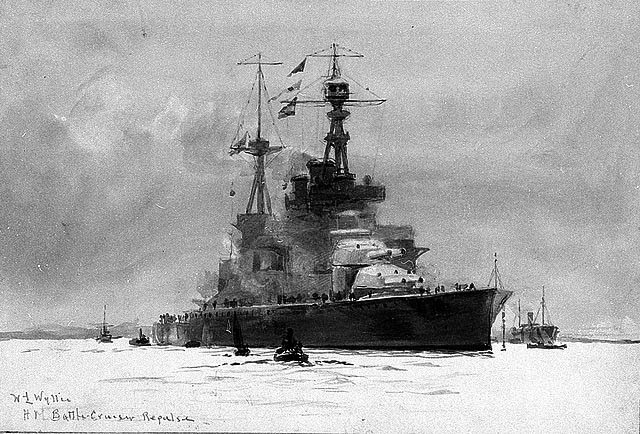
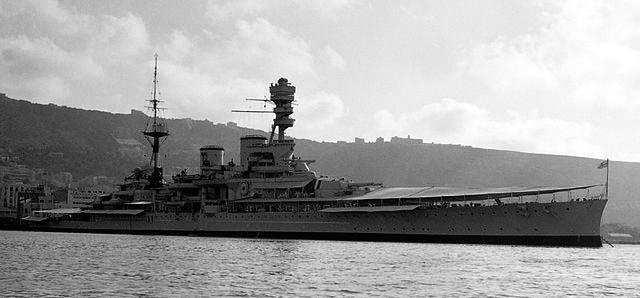
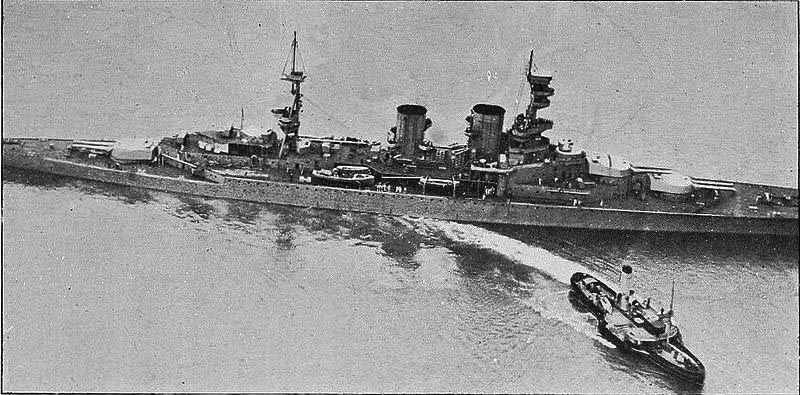
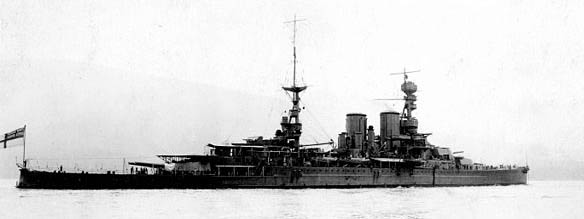
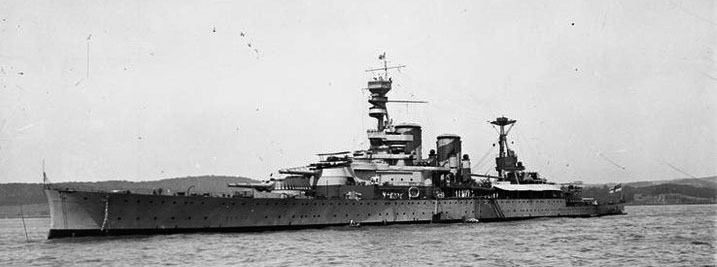

Links/sources
https://en.wikipedia.org/wiki/Renown-class_battlecruiser
en.wikipedia.org/wiki/HMS_Renown_(1916)
www.maritimequest.com/warship_directory/great_britain/battleships/renown_1916/hms_renown_1916.htm
www.naval-history.net/OWShips-WW1-02-HMS_Renown.htm
www.navypedia.org/ships/uk/brit_bb1_renown16.htm
Conway’s all the world’s fighting ships 1922-1947
Burt, R. A. (1993). British Battleships, 1919-1939. London: Arms and Armour Press.
Burt, R. A. (1986). British Battleships of World War One. Annapolis, Maryland: Naval Institute Press.
Campbell, John. (1985). Naval Weapons of World War Two. London: Conway Maritime Press.
Haarr, Geirr H. (2010). The Battle for Norway: April–June 1940. Annapolis, Maryland: Naval Institute Press.
Parkes, Oscar (1990). British Battleships (reprint of the 1957 ed.). Annapolis, Maryland: Naval Institute Press.
Raven, Alan & Roberts, John (1976). British Battleships of World War Two: The Development and Technical History of the Royal Navy’s
Battleship and Battlecruisers from 1911 to 1946. Annapolis, Maryland: Naval Institute Press.
Roberts, John (1997). Battlecruisers. Annapolis, Maryland: Naval Institute Press.
Smith, Peter C. (2008) [1976]. The Battle-Cruiser HMS Renown, 1916–1948. Barnsley, UK: Pen & Sword Maritime.
Stephen, Martin (1988). Sea Battles in Close-Up: World War 2. Annapolis, Maryland: Naval Institute Press.
Taylor, Bruce (2008). The Battlecruiser HMS Hood: An Illustrated Biography, 1916–1941. Annapolis, Maryland: Naval Institute Press.

Author’s illustration of the Renown in 1943



 Latest Facebook Entry -
Latest Facebook Entry -  X(Tweeter) Naval Encyclopedia's deck archive
X(Tweeter) Naval Encyclopedia's deck archive Instagram (@navalencyc)
Instagram (@navalencyc)





 French Navy
French Navy Royal Navy
Royal Navy Russian Navy
Russian Navy Armada Espanola
Armada Espanola Austrian Navy
Austrian Navy K.u.K. Kriegsmarine
K.u.K. Kriegsmarine Dansk Marine
Dansk Marine Nautiko Hellenon
Nautiko Hellenon Koninklije Marine 1870
Koninklije Marine 1870 Marinha do Brasil
Marinha do Brasil Osmanlı Donanması
Osmanlı Donanması Marina Do Peru
Marina Do Peru Marinha do Portugal
Marinha do Portugal Regia Marina 1870
Regia Marina 1870 Nihhon Kaigun 1870
Nihhon Kaigun 1870 Preußische Marine 1870
Preußische Marine 1870 Russkiy Flot 1870
Russkiy Flot 1870 Svenska marinen
Svenska marinen Søværnet
Søværnet Union Navy
Union Navy Confederate Navy
Confederate Navy Armada de Argentina
Armada de Argentina Imperial Chinese Navy
Imperial Chinese Navy Marinha do Portugal
Marinha do Portugal Mexico
Mexico Kaiserliche Marine
Kaiserliche Marine 1898 US Navy
1898 US Navy Sovietskiy Flot
Sovietskiy Flot Royal Canadian Navy
Royal Canadian Navy Royal Australian Navy
Royal Australian Navy RNZN Fleet
RNZN Fleet Chinese Navy 1937
Chinese Navy 1937 Kriegsmarine
Kriegsmarine Chilean Navy
Chilean Navy Danish Navy
Danish Navy Finnish Navy
Finnish Navy Hellenic Navy
Hellenic Navy Polish Navy
Polish Navy Romanian Navy
Romanian Navy Turkish Navy
Turkish Navy Royal Yugoslav Navy
Royal Yugoslav Navy Royal Thai Navy
Royal Thai Navy Minor Navies
Minor Navies Albania
Albania Austria
Austria Belgium
Belgium Columbia
Columbia Costa Rica
Costa Rica Cuba
Cuba Czechoslovakia
Czechoslovakia Dominican Republic
Dominican Republic Haiti
Haiti Hungary
Hungary Honduras
Honduras Estonia
Estonia Iceland
Iceland Eire
Eire Equador
Equador Iran
Iran Iraq
Iraq Latvia
Latvia Liberia
Liberia Lithuania
Lithuania Mandchukuo
Mandchukuo Morocco
Morocco Nicaragua
Nicaragua Persia
Persia San Salvador
San Salvador Sarawak
Sarawak Uruguay
Uruguay Venezuela
Venezuela Zanzibar
Zanzibar Warsaw Pact Navies
Warsaw Pact Navies Bulgaria
Bulgaria Hungary
Hungary

 Bundesmarine
Bundesmarine Dutch Navy
Dutch Navy Hellenic Navy
Hellenic Navy Marina Militare
Marina Militare Yugoslav Navy
Yugoslav Navy Chinese Navy
Chinese Navy Indian Navy
Indian Navy Indonesian Navy
Indonesian Navy JMSDF
JMSDF North Korean Navy
North Korean Navy Pakistani Navy
Pakistani Navy Philippines Navy
Philippines Navy ROKN
ROKN Rep. of Singapore Navy
Rep. of Singapore Navy Taiwanese Navy
Taiwanese Navy IDF Navy
IDF Navy Saudi Navy
Saudi Navy Royal New Zealand Navy
Royal New Zealand Navy Egyptian Navy
Egyptian Navy South African Navy
South African Navy






























 Ukrainian Navy
Ukrainian Navy dbodesign
dbodesign